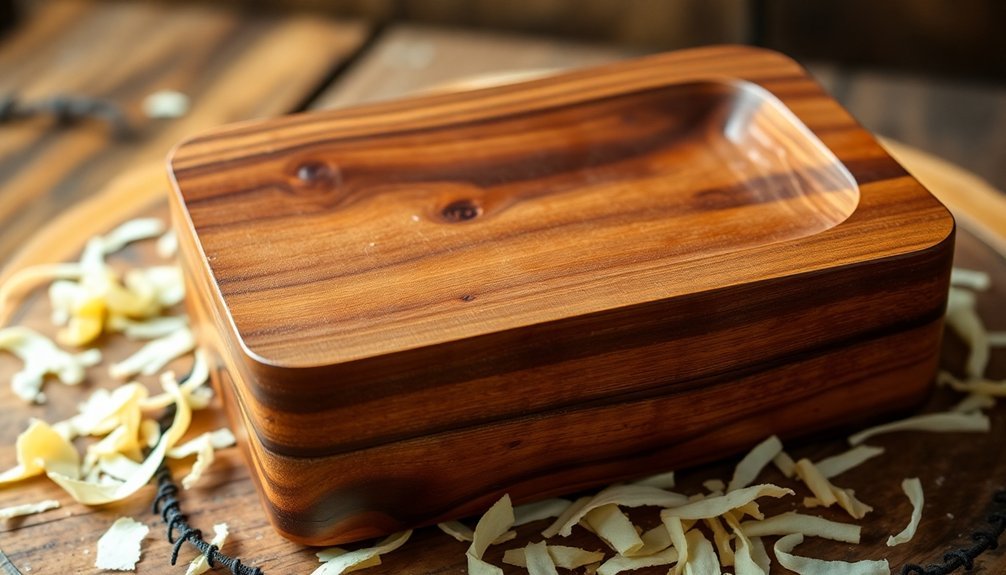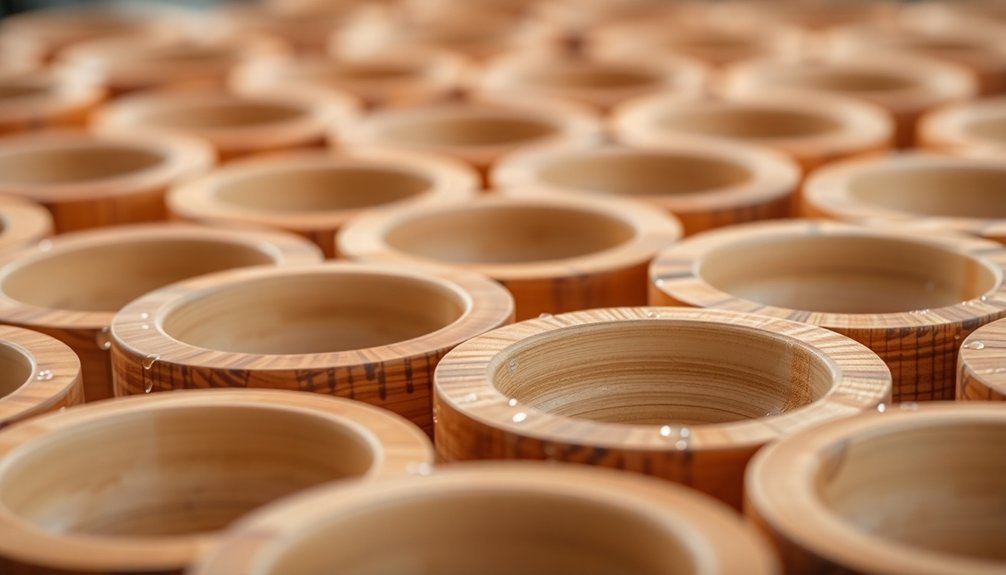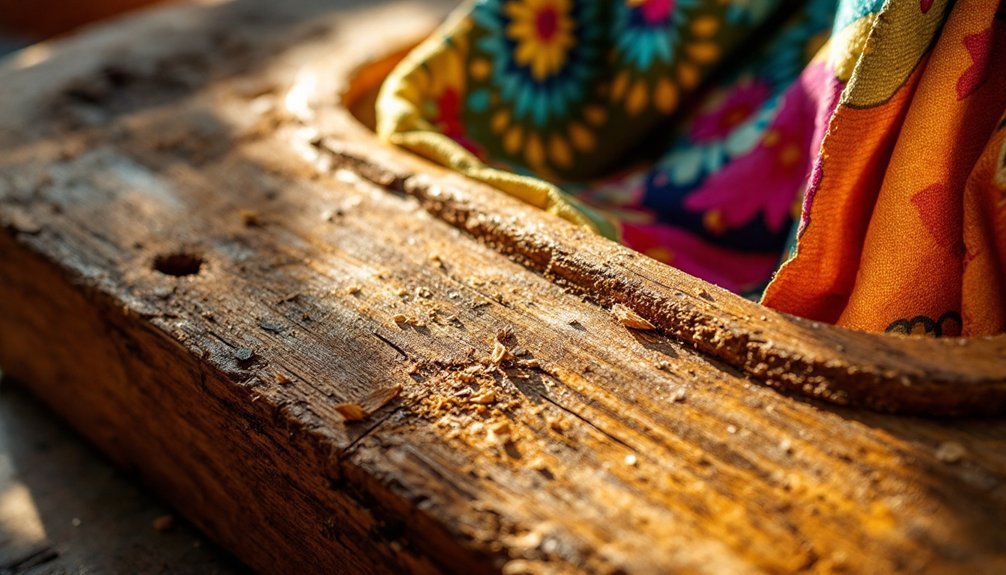Artisans line wooden soap molds to prevent their creations from sticking to the wood, making removal considerably easier. Proper liners also protect your molds from damage, extending their lifespan while ensuring smoother soap surfaces with well-defined details. You'll save considerable time during unmolding and cleanup, and different lining materials serve specific purposes based on your soap recipe and process. The right liner transforms your soap-making experience from frustrating to fulfilling.
Preventing Soap From Adhering to Wood: Essential Benefits of Mold Liners

The battle between soap and wooden molds has long challenged artisans in their craft. When you line your wooden molds, you're ensuring your soap comes out cleanly without sticking to the wood surface. This simple step not only makes removal easier but also protects your mold's integrity.
You'll notice immediate benefits in your workflow—less cleaning time, reduced damage to molds, and consistently smoother soap surfaces. Compared to silicone alternatives, wooden molds with proper lining allow for quicker unmolding under normal conditions.
The liner creates a barrier that prevents moisture from seeping into the wood, which would otherwise cause warping and staining over time. Your soap maintains its intended appearance without picking up discoloration or texture imperfections from direct wood contact.
With proper lining, you'll extend your mold's lifespan while enhancing your soap's professional finish.
The Art of Selecting Appropriate Lining Materials for Different Soap Recipes
Your choice of lining material should align with your specific soap recipe, as certain ingredients react differently with various liners.
When working with potent fragrance oils, you'll need more durable materials like silicone or Teflon that won't break down or absorb scents. HDPE molds are also excellent choices as they do not degrade from essential or fragrance oils and can withstand temperatures up to 200°F.
Cold process soaps typically benefit from moisture-resistant liners like freezer paper, while hot process formulations work best with heat-tolerant options such as silicone or oil cloth.
Material-Recipe Compatibility Matrix
When crafting artisanal soaps, selecting the right lining material becomes essential for ensuring successful demolding and preserving your soap's aesthetic appeal. Your soap's composition directly influences which lining works best.
For high-oil content formulations, silicone paper provides excellent release properties, while parchment paper works well with harder, lower-moisture recipes.
When incorporating herbs or clay additives, polypropylene films offer superior resistance to sticking. Cold process soaps generating significant heat during saponification require heat-resistant linings like cotton fabric.
Consider your wooden mold's characteristics too—untreated wood absorbs moisture more readily than treated surfaces. You'll need more robust lining for recipes with extended curing times. Soaps with high glycerin content may benefit from more absorbent linings since glycerin attracts moisture from the environment during the curing process.
Remember that eco-friendly options like reusable cotton fabric might require additional preparation but reduce environmental impact over single-use alternatives.
Fragrance Oil Considerations
Fragrance oils present unique challenges when selecting appropriate lining materials for wooden soap molds, as their chemical properties can interact with both the soap mixture and lining itself.
You'll notice that essential oils tend to be more aggressive than fragrance oils, potentially requiring more robust linings to prevent sticking.
When working with strongly scented formulations, choose lining materials that minimize absorption and resist degradation over time.
Some fragrances can weaken certain liners, compromising their effectiveness after repeated use.
Consider applying release agents like shortening or oil to enhance soap removal, especially with sensitive fragrances that might otherwise adhere to the mold.
You may need to customize your lining strategy based on specific fragrance oil properties—what works for floral scents mightn't be ideal for citrus or spice varieties.
Grease-proof paper is ideal for lining wooden molds as it creates a barrier that prevents both sticking and scent absorption into the wood.
Cold vs. Hot Process
The fundamental differences between cold and hot process soap making greatly influence your choice of lining materials for wooden molds.
Cold process soap requires more extensive lining as it undergoes a slower saponification period while maintaining its liquid state longer. Freezer paper is ideal here, providing a non-stick surface that preserves your soap's smooth finish and intricate designs.
Hot process soap, meanwhile, can often manage with minimal lining. Since you're working with cooked soap that saponifies more quickly, you'll find it releases from molds more easily. For block molds specifically, be aware that freezer paper may leak when used as a liner.
While parchment paper can work, it's less ideal than freezer paper due to potential sticking issues.
Consider your priorities: cold process offers creative freedom and refined aesthetics, while hot process trades precise appearance for time efficiency and functionality.
Historical Evolution of Wooden Mold Preparation Techniques
Throughout human history, wooden molds have evolved from simple carved implements to sophisticated instruments of artistic expression. What began in the Bronze Age with basic pottery and metalcasting applications gradually transformed as woodcarvers refined their craft.
By the 15th century, European woodcarvers had established their own guilds, elevating mold design to new levels of intricacy. You'd find artisans selecting specific woods like cherry and pear for their durability and ability to hold fine details. These craftsmen created religious motifs and mythological symbols that reflected cultural values of their time.
The mid-19th century brought significant change with mechanization. Machine-processed molds made architectural trims more accessible and cost-effective, though this shift affected the complexity of designs as production techniques shifted from handcrafted precision to mechanical efficiency.
Maintaining Your Wooden Molds for Generations of Soap Making

Properly maintained wooden soap molds can serve your creative endeavors for decades, making them worthy investments for serious soap makers.
After each use, clean with isopropyl alcohol and paper towels rather than submerging in water, which causes warping. Always dry thoroughly after wiping with a damp cloth.
Protect your molds with oil or wax finishes—never paints or varnishes that might react with soap ingredients. The light, non-treated pine wood commonly used for soap molds must remain free of toxic treatments to ensure product safety.
Always line with freezer paper or silicone to prevent sticking and protect the wood from moisture. Regularly inspect for signs of wear or damage, especially around joints and corners.
Store your molds in a dry location between uses.
With these simple care strategies, your wooden molds will remain reliable tools for countless batches of artisanal soap, preserving their integrity and functionality.
How Proper Lining Affects the Final Appearance of Your Handcrafted Soaps
When you line your wooden soap molds properly, you'll achieve crisp, smooth edges that give your bars a professional finish.
The right lining material creates clean boundaries between soap and wood, preventing jagged or rough surfaces that might detract from your handcrafted design.
Well-fitted liners can also help transfer intricate patterns to your soap's surface, allowing you to create detailed textures that would otherwise be lost with improper lining techniques. Removable ends make the soap extraction process significantly easier when using properly lined wooden molds.
Smooth Soap Edges
The careful lining of wooden soap molds directly impacts the final appearance of your handcrafted soaps, particularly when it comes to edge quality. Your choice of liner material determines whether you'll achieve professional-looking results or face disappointment. Wood molds require lining with freezer paper to prevent soap from sticking to wood.
| Lining Material | Edge Quality | Reusability |
|---|---|---|
| Freezer Paper | Smooth, crease-free | Single use |
| Parchment Paper | May show wrinkles | Single use |
| Silicone Liners | Professional-looking | Highly reusable |
When you use freezer paper correctly, you'll enjoy smooth edges without creases. Plastic bags and oil cloth also provide flat surfaces that prevent irregularities in your soap's appearance. While parchment paper is popular, its tendency to wrinkle can affect your soap's edges. For consistently professional results, silicone liners offer superior release and the smoothest possible finish.
Pattern Transfer Benefits
Investing in the right lining for your wooden soap molds yields remarkable pattern transfer benefits that elevate your soap designs to professional standards.
When you use materials like freezer paper or silicone liners, you'll achieve smooth, effortless soap removal without damaging your intricate designs.
Proper lining creates a non-stick surface that preserves even the most elaborate patterns intact. You'll notice improved aesthetics with evenly textured surfaces that showcase your craftsmanship.
Your soap's color consistency remains uniform without unwanted mold interactions that could compromise your vision.
The right lining empowers you to experiment with complex, multi-layered designs you couldn't risk with unlined molds. Using heat-safe materials for lining ensures your mold won't melt during the exothermic reactions of soap-making.
Textured details remain crisp and well-defined, allowing your artistic expression to shine through without the frustration of stuck soap or distorted patterns.
Time-Saving Benefits: Streamlining the Unmolding and Cleanup Process

For professional soap artisans seeking to enhance their productivity, lined wooden molds offer substantial time-saving benefits throughout the production process.
You'll find that soap releases more easily from lined molds, reducing physical strain and preventing sticking issues that can damage your product.
The cleanup process becomes remarkably more efficient when using liners. You'll spend less time scraping residue from wooden surfaces and minimize your exposure to harsh lye residues.
Using liners dramatically cuts cleanup time—less scraping, less exposure to harsh lye, more time for creativity.
Since liners protect your molds from direct chemical contact, your equipment will last longer and require less maintenance over time.
Your workspace stays more organized as lined molds can be quickly emptied, cleaned, and stacked for storage.
This streamlined workflow lets you focus on creating rather than struggling with stubborn unmolding and tedious cleanup tasks.
Expanding Your Craft: How Lined Wooden Molds Enable Diverse Soap Making Methods
Beyond saving time, lined wooden molds reveal an entirely new dimension in your soap making repertoire. With proper liners, you'll confidently explore techniques that were previously challenging or impossible.
Different liner materials accommodate various recipes, allowing you to experiment with additives that might otherwise react with unprotected wood. Wood molds require mineral oil treatment periodically to maintain their integrity when used without liners.
- Temperature-sensitive methods like CPOP become accessible as liners help regulate and maintain ideal curing conditions.
- Artistic swirls and intricate designs stay pristine when you can cleanly unmold without damaging your creation.
- Specialized gel phase effects emerge more consistently thanks to the insulation liners provide.
- Custom-shaped soaps become practical when liners prevent sticking in uniquely carved wooden molds.
- Batch-to-batch consistency improves dramatically, elevating your craft from hobby to professional-grade production.
Frequently Asked Questions
Can Wooden Molds Be Used Without Any Lining Material?
You can use wooden molds without lining, but you'll face challenges with soap adhesion, difficult unmolding, potential mold damage, and tougher cleaning. It's possible but not recommended for best results.
How Long Should Wooden Molds Dry After Cleaning?
You should dry wooden molds for 24-48 hours after cleaning. Make certain moisture content drops below 20%. Use fans and dehumidifiers to speed up the process. Thicker woods require longer drying times.
Are Some Woods Naturally Better for Soap Molds Than Others?
Yes, some woods are naturally better for soap molds. You'll want seasoned hardwoods for durability and non-treated pine for insulation. Avoid plywood due to glue concerns. Untreated woods prevent soap contamination.
Can I Reuse Liners for Multiple Batches of Soap?
Yes, you can reuse silicone liners for multiple soap batches. Clean them thoroughly between uses to prevent contamination. Paper-based liners typically can't be reused as they tear easily and stick to soap.
Do Handmade Wooden Molds Perform Differently Than Manufactured Ones?
Yes, you'll notice handmade wooden molds offer better heat retention and customization flexibility, while manufactured ones provide more consistency. Your handmade molds can be adjusted during production but might show slight variations in sizing.
In Summary
By lining your wooden soap molds, you'll protect both your creations and your equipment. You're not just ensuring easier unmolding and cleaner designs; you're preserving your cherished tools for years to come. Whether you've chosen silicone, parchment, or fabric liners, you've made an investment in efficiency and quality. With proper lining techniques, you'll enjoy more creative freedom and considerably less cleanup time.





Leave a Reply